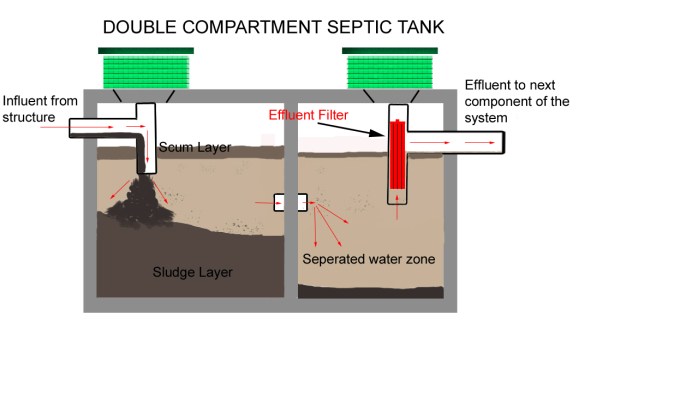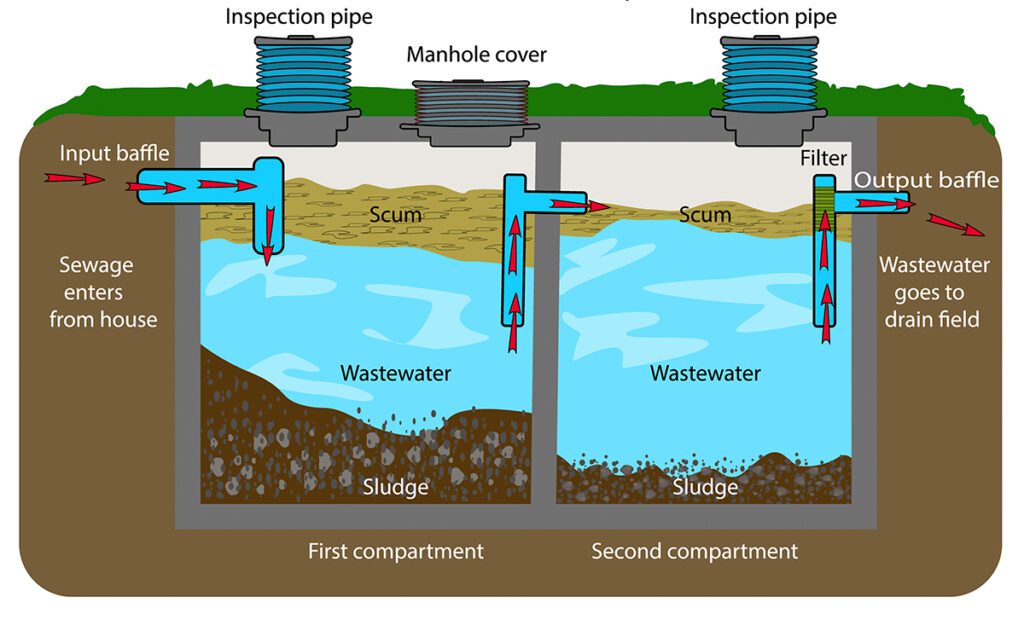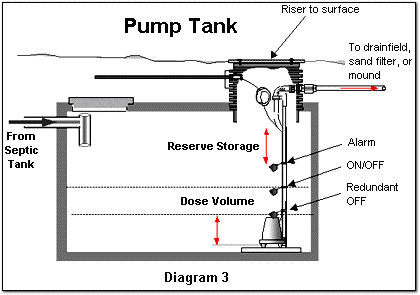In this article, you will learn all about the “Septic Tank with Pump Chamber” and its vital role in onsite systems. We will explain the importance of pumping and how it contributes to the proper functioning of septic tanks. Whether you are a homeowner or a professional in the field, this article will provide you with a comprehensive understanding of septic systems and the crucial role of the pump chamber. So, let’s dive in and explore the world of septic tanks and pumping!
Overview of Septic Tank with Pump Chamber
What is a septic tank with pump chamber?
A septic tank with pump chamber is a specialized type of septic system that includes an additional pump chamber to facilitate the efficient movement and discharge of wastewater. This system is commonly used in areas with challenging topography, such as properties that are located uphill or far away from the main sewage lines.
How does it differ from a traditional septic system?
Unlike a traditional septic system, which relies solely on gravity for the movement of wastewater, a septic tank with pump chamber utilizes a pump to push the effluent uphill or against resistance. This additional pump chamber provides more flexibility in system design and allows for the installation of septic systems in areas that would otherwise be unsuitable for a traditional system.
Importance of Pumping in Onsite Systems
Why is pumping necessary?
Pumping is a crucial maintenance task for septic tank with pump chamber systems. Over time, solids and sludge accumulate in the tank, and without regular pumping, the system can become overloaded and fail to effectively treat and dispose of wastewater. Pumping removes the accumulated solids and prevents clogging, ensuring the continued functionality and longevity of the system.
Effects of neglecting pumping
Neglecting pumping in a septic tank with pump chamber can have severe consequences. Without regular maintenance, the accumulated solids can clog the system, leading to backups, odors, and potential damage to the pump and other components. This can result in costly repairs or even the need for the complete replacement of the system.
How often should pumping be done?
The frequency of pumping depends on various factors, including the size of the tank, the number of occupants in the property, and the volume of wastewater generated. As a general guideline, it is recommended to have a septic tank with pump chamber pumped every three to five years. However, it is best to consult a professional to determine the specific pumping schedule based on the individual circumstances of your system.

Components of a Septic Tank with Pump Chamber
Pump chamber
The pump chamber is a vital component of the septic tank with pump chamber system. It is a separate chamber connected to the septic tank that houses the pump, float switches, and check valves. The pump chamber collects and stores the wastewater before pumping it out to the drainage or disposal area.
Pump
The pump is responsible for pushing the wastewater from the pump chamber to its intended destination. It creates the necessary pressure to overcome any uphill slopes or resistance in the system. The pump is typically activated by float switches or a control panel and is designed to handle the specific requirements of the septic system.
Float switches
Float switches are an important part of the pump chamber as they activate the pump based on the water level. When the water level in the pump chamber reaches a certain height, the float switches trigger the pump to turn on and begin pumping the wastewater out of the system. They ensure that the pump operates efficiently and prevents overflows or underutilization of the pump.
Alarms
Alarm systems are often installed in septic tank with pump chamber systems to alert homeowners or professionals of any malfunctions or abnormalities. These alarms can detect issues such as high water levels, pump failures, or power outages. The timely notification provided by these alarms allows for prompt action to be taken to prevent further damage to the system.
Check valves
Check valves are one-way valves that prevent the backflow of wastewater into the pump chamber. They are installed in the discharge lines and ensure that the effluent flows only in the desired direction. Check valves are essential to prevent any potential contamination of the pump chamber and to maintain the proper functioning of the septic system.
Functioning of a Septic Tank with Pump Chamber
Inflow of wastewater
In a septic tank with pump chamber system, wastewater flows from the property’s plumbing fixtures into the septic tank. The septic tank acts as the primary treatment unit, where solid waste settles to the bottom and forms a layer of sludge, while lighter materials float to the top and create a scum layer. The partially treated effluent then flows into the pump chamber for further processing and disposal.
Separation of solids and liquids
Within the septic tank, the process of anaerobic digestion takes place, where bacteria break down the organic matter in the wastewater. This natural process helps separate the solids from the liquids, allowing for more efficient treatment and reducing the load on the pump chamber. Regular pumping is necessary to remove the accumulated solids and maintain the overall functionality of the system.
Activated pumping mechanism
When the water level in the pump chamber reaches a predetermined height, the float switches activate the pump. The pump then starts pumping the effluent out of the system and into the drain field, disposal area, or further treatment. The pump creates the necessary pressure to overcome any elevation changes or resistance in the system and ensures the proper flow of effluent.
Discharge of effluent
The effluent that has been pumped out of the pump chamber is discharged into the designated drain field or disposal area. Here, the effluent undergoes further natural treatment as it percolates through the soil, where bacteria and other organisms continue to break down any remaining contaminants. The treated wastewater is then safely returned to the environment.
Role of the Pump Chamber in Onsite Systems
Collecting and storing wastewater
The pump chamber plays a crucial role in collecting and storing the wastewater before it is pumped out of the system. It acts as an intermediary between the septic tank and the final disposal area, ensuring that the effluent is properly treated and released. The pump chamber allows for the efficient movement of wastewater even in challenging topographical conditions.
Creating pressure for effluent discharge
One of the primary functions of the pump chamber is to create the necessary pressure to overcome uphill slopes or resistance in the system. As the pump activates, it generates the required force to push the effluent from the pump chamber to its intended destination, whether it be a drain field, disposal area, or further treatment unit. The pump chamber enables the effluent to be effectively distributed or discharged.
Alarm system for malfunctions
The pump chamber is often equipped with an alarm system to detect and notify homeowners or professionals of any malfunctions or issues in the system. These alarms may indicate high water levels in the pump chamber, pump failures, or power outages that affect the operation of the system. The alarm system allows for timely intervention and prevents further damage or system failure.
Selection and Sizing of Pump Chambers
Factors to consider in pump chamber selection
When selecting a pump chamber for a septic tank with pump chamber system, several factors need to be considered. These factors include the property’s size, the number of occupants, the volume of wastewater generated, and the site’s topography. Additionally, the chosen pump chamber should be compatible with the specific pump, float switches, and other components of the system to ensure optimal performance.
Determining the appropriate size of the pump chamber
The size of the pump chamber is determined based on the estimated volume of wastewater generated by the property. This estimate takes into account factors such as the number of bedrooms, bathrooms, and the daily water usage. It is crucial to select a pump chamber that can accommodate the expected wastewater flow while providing sufficient storage capacity for the pump to operate effectively.

Maintenance and Troubleshooting of Pump Chambers
Regular inspection and monitoring
Regular inspection and monitoring of the pump chamber are essential to ensure its proper functioning. This includes checking the water levels, float switches, alarms, and any visible signs of leaks or damage. Regular inspection allows for early identification of potential issues and prompt maintenance or repairs, preventing more extensive damage to the system.
Pump maintenance
Proper maintenance of the pump is crucial to its longevity and performance. This includes regular cleaning, lubrication, and inspection of the pump components, as well as checking for any signs of wear or damage. It is recommended to follow the manufacturer’s guidelines for pump maintenance and to have a professional pump service technician perform routine inspections and maintenance tasks.
Potential problems and troubleshooting
In septic tank with pump chamber systems, several common issues can arise, including clogged discharge lines, pump failures, float switch malfunctions, or alarm system problems. Troubleshooting these problems may require assessing the electrical connections, checking for clogs, replacing worn-out components, or adjusting the float switches. It is advisable to consult a professional for troubleshooting and repairs to ensure the proper functioning of the system.
Benefits of Using a Septic Tank with Pump Chamber
Efficient wastewater management
A septic tank with pump chamber system allows for more efficient and effective wastewater management, particularly in challenging or uphill locations. The addition of a pump chamber enables the system to overcome topographical obstacles and ensures the proper movement and disposal of wastewater. By facilitating efficient wastewater management, these systems help maintain a healthy and clean environment.
Reduced risk of system failure
Regular pumping and maintenance of a septic tank with pump chamber system significantly reduce the risk of system failure. By removing the accumulated solids and ensuring the proper functioning of the pump and other components, these systems can operate optimally for many years. Proper maintenance also minimizes the likelihood of backups, odors, and costly repairs, providing peace of mind to homeowners.
Flexibility in system design
The inclusion of a pump chamber in a septic system provides greater flexibility in system design. This flexibility allows for the installation of septic systems in areas that would otherwise be unsuitable for traditional gravity-based systems. The pump chamber allows for the efficient movement of wastewater against resistance, making it possible to design and install septic systems in challenging topographical conditions.
Cost Considerations for Septic Tank with Pump Chamber
Initial installation costs
The initial installation costs of a septic tank with pump chamber system can vary depending on several factors. These factors include the size of the property, the complexity of the topography, the availability of suitable disposal areas, and the specific requirements of the system. While the initial costs may be higher than those of a traditional septic system, the added functionality and flexibility provided by a pump chamber can outweigh the initial investment.
Pumping and maintenance expenses
Regular pumping and maintenance are necessary for septic tank with pump chamber systems, and these tasks incur additional expenses. The frequency of pumping and the cost of professional maintenance services can vary depending on the size of the system, the number of occupants, and the volume of wastewater generated. However, considering the potential consequences of neglecting these tasks, the expenses associated with pumping and maintenance are essential investments in the system’s long-term functionality.
Long-term cost-effectiveness
While the initial costs and ongoing pumping and maintenance expenses must be considered, a properly maintained septic tank with pump chamber system can be cost-effective in the long run. By preventing system failures, backups, and major repairs, these systems minimize the risk of expensive emergencies. Additionally, the flexibility and efficiency of a pump chamber system can offer long-term benefits, such as the potential for future property expansion and increased property value.
Environmental Considerations
Impact on groundwater quality
A properly functioning septic tank with pump chamber system can have a positive impact on groundwater quality. By effectively treating wastewater and removing contaminants, these systems help prevent the pollution of groundwater sources. Regular pumping and maintenance ensure the continued effectiveness of the system and minimize the risk of groundwater contamination, preserving the quality of this vital resource.
Possible contamination risks
If a septic tank with pump chamber system is not properly maintained, it can pose potential contamination risks. Neglected systems can result in the leakage of untreated wastewater into the surrounding environment, potentially contaminating nearby water sources or soil. Regular pumping, inspection, and maintenance are essential to prevent such contamination and ensure the safe and responsible disposal of wastewater.
Mitigation measures
To minimize the environmental impact of a septic tank with pump chamber system, several mitigation measures can be implemented. These measures include regular maintenance and inspections, proper pumping schedules, and the use of environmentally friendly cleaning products. Additionally, property owners can consider implementing water conservation measures to reduce the volume of wastewater generated, further minimizing the system’s environmental footprint.
In conclusion, a septic tank with pump chamber system offers an efficient and flexible solution for onsite wastewater management. Regular pumping, maintenance, and inspection are crucial to the proper functioning of the system and to prevent costly system failures. By understanding the importance of pumping and the role of the pump chamber, homeowners can ensure the longevity and effectiveness of their septic systems while minimizing their environmental impact. With proper care and maintenance, a septic tank with pump chamber system can provide reliable and sustainable wastewater management for many years to come.

